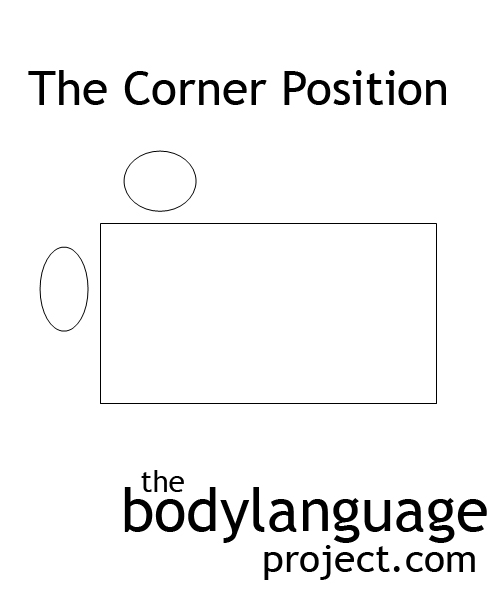Touch reduction is usually accompanied with stressful questions or when information is presented that creates anxiety. Closeness can also be useful when assessing someone because it will invoke distancing desires. When talking with a spouse or child, sit as close as that which you are accustomed to before taking up serious matters. If someone is hiding something, they will usually push away or even stand up looking for ways to exit or change the subject. Holding the hand of a child can be particularly useful when discussing matters of dishonesty. If they wish to exit the discussion, they will try to tug their hand away.
Tag Archive for Closeness
Summary – Chapter 15
by Chris Site Author • March 6, 2013 • 0 Comments
Seating arrangements is one of the things we infrequently draw to conscious attention but at some level always understand its importance. In this chapter we looked at what seems on the outset to be a complicated matter, but in reality is fairly straight forward and like all body language, once it is know, common sense. We found that seating positions can indicate our reason for meeting, be it ‘affiliation’ – to build group cohesion, ‘achievement’ – to get things done, or ‘power’ – to emphasis control. We found that the meeting organizer typically dictates how meetings will transpire.
We learned that Sommer first began researching seating ecology and that patterns emerged based on the shape of the table and the proximity speakers had to one-another. We found that a casual corner position where speakers meet across the corners of a rectangular or square table preserve closeness between people, but still offers the security of a partial barrier. We found that when seated side-by-side cooperation is fostered, when facing across from one-another but not head-on, independent though is fostered, and when facing directly, competition. We found that leadership studies show us what we intuitively already know, that leaders take up the head position, that those at his or her flank receive trickle down leadership and that when seating is pre-determined, leadership is assigned to the head of the table. We found that square tables includes both competitive and cooperative seating positions, that circular tables had similar affects despite what King Arthur thought, and that strategically we can sway our “object” by taking up competitive and affiliative positions.
Next we looking at how to set up an office and found that desk placement and office artifacts are crucial and that chairs can make people uncomfortable or powerful depending on their height and location. We then looked at seating arrangements in larger auditoriums and saw that the center of lecture halls tended to be overlooked, and also how to use this to our advantage, and finally we concluded the chapter by pointing out that seating location affects participation; those in front participating most, but that it did not related to test scores.
Casual Corner Position
by Chris Site Author • March 6, 2013 • 0 Comments

The “casual corner” seating arrangement is best in business as it the table provides are partial barrier, yet does not prevent people from interacting together effectively.
The casual corner position is most appropriate to preserve closeness between people, but at the same time offers a partial barrier. The barrier in this case, is the corner of the table. If chairs are directly facing the table, it avoids direct eye contact, but if preferred, the chairs can face one another across the corner of the table to make sharing of information easier. This seating position is unique because it neatly allows for independent thought, but the proximity still permits intimacy.
When presenting new information to a client or trying to “sell them”, this is the most preferred orientation. It is also a useful way to conduct an interview without coming off as aggressive or competitive. In studies when students were asked to choose a seating arrangement that permitted conversation, this was the most often chosen arrangement.
How We Prefer To Orient Ourselves When Standing
by Chris Site Author • March 6, 2013 • 0 Comments
Most people would state that standing square, face-to-face was the most honest and trustworthy position people orient themselves in while speaking with someone, but they would only be half right. In fact, most Americans stand at forty-five degrees or at oblique angles to one another. Facing someone dead on, is how boxers square off to one another in the pre-show weigh-in or when two men near physical contact at a bar. The head on orientation is reserved for confrontation with just one exception. That is when two people are really comfortable with each other.
In confrontation people get really close to one another and stare into each others eyes as a signal of dominance. This stance has a basis in escape since it is much easier to exit left or right from a tilted position rather than one that squares you off to someone else. When we want to exit from a confrontational stance we need to pivot or shift first which requires more movement and puts is in peril. However, orienting at oblique angles mutually tells us that we aren’t trying to corner each other, but when confrontation is not a remote possibility, facing straight-on is a demonstration of extreme comfort and trust.
Other cultures don’t feel this way. Arabic cultures for example will speak with one another with their faces nearly touching, which isn’t rare, in fact it happens during normal conversation. Women in American cultures tolerate such closeness only from another woman. Men who do this to women will be perceived as sexually interested and be seen to be making a sexual come-on. If not welcomed closeness will be a threat and turn-off, and in an office situation, should definitely be avoided.
Tonality Advice For Men
by Chris Site Author • March 6, 2013 • 0 Comments
As we have seen in a pervious chapter, tonality plays a big part in the meaning and intent of the message being delivered. Speaking in a soft voice can be construed as nervous, especially if words are so quiet they are misheard. When in groups containing new people, it is very common to speak quietly to direct your conversation to specific people you are more familiar with, however this can and will alienate others and serve to isolate you further. While in a group, therefore, don’t be afraid to address everyone and save private conversations for later. Whispering, which is an entirely different ballgame can actually bring women closer and create sparks, so is fair technique to explore. As tonality pertains to dating and attraction, it is important to hold a strong voice and use projection to carry it to your audience. Speaking too loudly can come across as forceful and arrogant though, so try to balance your speech to your location and audience, as well as the surrounding noise.
As mentioned earlier, women find men with voices that are deep sexy and it is possible to lower the breadth of your voice with practice. Even keeping it monotone will make it seem deeper and sexier, although a lack of enthusiasm will likely out-weight the benefits. Calming and slowing the voice can also deepen it and these techniques can be perfected when practiced. Naturally each one of the techniques for voice lowering can appear forced and awkward, and in most cases, the voice can only be lowered by a few degrees, but this might be all that is required to bring a high pitched voice down to an acceptable medium.
Another aspect of voice is projection. In nightclubs where talking is often difficult at best, you might consider extending the length of words and phrases, so they are better heard. Men should never pass up an opportunity for closeness, and as mentioned, whispering is a great tool to accomplish this. A “hey, let’s get out of here, it’s too loud to talk” makes for a good exit strategy once a connection is formed. Regardless of the situation, a well projected voice communicates strength and confidence.
Men should also be mindful of nervous laughing and long bouts of monotone speech, which can be a killer for women. Men should avoid getting overly excited, but should also not be afraid to liven speech with gestures and some changes in pitch, to show that they have a pulse, and that their life is at least somewhat exciting. If men find themselves in conversation with an unwilling participant, they should change gears or change partners, this is what makes body language so powerful, since it eliminates the need to second guess interest. Having read the cues to sexual interest at the beginning of this chapter along with interest in general covered throughout the book, it should be plainly obvious what others are thinking about you.
Proximity, Pointing And Touching
by Chris Site Author • March 6, 2013 • 0 Comments
Proximity plays a huge factor in dating and anything done to decrease space between tow people is a good signal of attraction. Sometimes, closeness is real, for example a woman might get up and physically move closer to a man, she might move a chair next to him or she might opportunistically take up a position close-by on a sofa. All cues that are important give alternative options to sit. Sometimes too, proximity is figurative such as is the case when women point, or when eyes are cast.

The “pointing knee” happens when a woman sites on her foot and aims her knee toward the man of interest.
Pointing, like eyeing, are ways to bring people close together without actually moving. Both are reliable indicators of where we’d rather be, or who we are thinking about. We can point with our eyes, our toes or feet, or our knees. The pointing knee happens when a woman sites on her foot and aims her knee toward the man of interest. This is sometimes also a signal of being relaxed and informal which extends the meaning of the pointing knee. Escape is difficult in this position so when done by a woman it means that she is comfortable around whomever she is with at the time. Dangling a shoe is another informal signal of comfort for the same reason. The pointing knee also shows fleeting glimpses to the inner thigh which can be arousing to men. Leaning in or toward, standing next to someone or even isolating oneself from friends all shows interest when done by women.
Touching is another great signal of attraction even if it happens ‘accidentally’. Women will make a point to brush up against men of interest and as we have seen may groom them if they wish to send a strong message. Have you ever wondered if he or she really likes you? Try accidentally brushing a knee or leg up against someone under the table. If they pull away or turn immediately than it’s due to disinterest, but if it’s embraced and “footsies” ensue then it’s an excellent signal of interest. To make sure the signal is anchored try casting occasional flirty eye contact. This is a signal that can be used by either men or women. When outside of a dating context, the same pulling away will be found so this isn’t limited to courtship. People that hate each other like to maintain as much space as possible and even accidental touching is unwelcome.
Leaving a tie un-straightened can give women an excuse to touch and is a great way to measure interest by men. To send a much more subtle signal of touching an object might take the place of a person. Such is the case with caress the stem of a wine glass, ring, watch or car keys. The back of the hand, the neck, the shoulders, or side of the face can also show interest. Self touching is a way to prepare the body for touching by someone else and also indicates what type of touching women wish to receive. Self-touching is a ‘fix’ that is used to alleviate the symptoms of the desire to be touched, and indicates where a women’s mind is thinking.
Research Into Purposeful Mirroring
by Chris Site Author • March 6, 2013 • 0 Comments
A 1999 study by Tanya Chartrand and John Bargh, showed that forced mirroring had a positive effect on liking. In this study, half of the time researchers either mimicked or did not mimic subjects. The remaining actions and behaviours remained the same across both groups meaning that the only factor being manipulated was either mimicry or lack thereof. The participants who had been mimicked reported a greater liking and reported that the conversation carried on much smoother then what was reported by subjects that did not receive any mirroring.
Another study showed that mimicry arouse spontaneously amongst strangers. In this study, participants were examined interacting on two separate occasions. In the first session the researcher interacted with the subject while purposely rubbing their face and in the second, they shook their foot. Videotapes of the session showed that the participants mirrored the actions of the researcher, that is, when the researcher rubbed their face, they did too, and when they shook their foot, so too did the subject. At the end of the study, when asked of their awareness of their mannerisms the subjects pleaded ignorance to their mimicry. This suggests that imitation when around others is spontaneous and happens without prompting. In other words, we naturally imitate others.
Dutch researcher Rick van Baaren and colleagues in a 2003 study demonstrated that mirroring leads to a greater sense of closeness between people. In this marketing study, body posture and mannerisms of participants was either imitated or not. Subjects that were mirrored rated the researchers significantly higher on a closeness rating scale. Thus, despite feigned mirroring, subjects still reported greater liking. In a second study it was found that tipping size increased by sixty-eight percent simply by verbally repeated the orders of patron and in a third study, individuals were more likely to help someone who had dropped items when they had been previously mirrored.
Mirroring can therefore be a powerful and practical tool when used deliberately as evidenced by the research. The research suggests that the propensity to mirror is an adaptive way to converse more efficiently and smoothly. Several other studies show us that people are both more likely to imitate others whom they like, and also like those of which they imitate. This has implications on persuasion since liking has a profound effect on our influence of others. The research also tells us that others are not normally aware of the mirroring that is happening around them, nor of the effect mirroring has on their actions and beliefs. In essence, mirroring is an effective and powerful tool which can be used to create bonds, build rapport, and in essence, get what we want from others.
Invasion Of Space
by Chris Site Author • March 6, 2013 • 0 Comments
Most hostile interactions in our lifetime will fall short of physical conflict but that doesn’t mean aggression was never present. We hold a buffer around our bodies at a premium and yet others still fail to acknowledge this, and choose to move closer then we wish. Disrespecting someone’s personal space is a form of aggression and dominant individuals routinely ignore personal space buffers, in fact, it’s one of the ways they maintain their dominance! Invasion of personal space can even come from brief touching or pats on the back, but also from more inappropriate touching such as jabs to the ribs with fingers, pens, or worse yet, slaps to the buttocks! Sometimes space invades will gain unwanted closeness by using friendly conversation, that we naturally read correctly as feigned.
Overstepping territorial boundaries is obvious to almost everyone because most have at least a rudimentary ability to read body language. We can test proximity comfort levels by stepping only so close as that which causes the next party to step or lean back. Leaning back carries the same weight, as a message, as a full or partial step back, it is just more polite. We can use the step back technique to send this message to space invaders, but it is often ineffective, as their intentions are usually intended to yield such results. Stepping back, and then quickly placing an open palm on their wrist or arm, or hovering a hand palm-vertical near the midline between you and them will serve to anchor them, preventing further advances. Often, the only solution is to be outright with the invasion and call them out. In this case, we should expect it to cause openly negative feelings which could strain a relationship, so should be carefully considered.
The Stiff Or Curved Arm
by Chris Site Author • March 6, 2013 • 0 Comments

The stiff arm is an obvious signal that approach is unwelcome as it forms a solid barrier around our personal space zone.
A more obvious defensive posture is the stiff arm which happens by thrusting the arm forward and away from the body with the palm face vertical in a “stop” type signal. Another defensive posture is the curved arm, a variation of the stiff arm, where the arm is bent and locked at the elbow and thrust outward facing down or horizontally. As a cluster, the stiff arm and curved arm is accompanied by a step backwards to reclaim stolen space, which is the true intention of the stiff arm. Both postures are called “arm-distancing” tactics because the arms are used to control space. When we say “Keeping people at arms length” this is the body language we refer to. The curved arm also creates a closed body position since the arm crosses over the middle of the body. At times, the arm fails to come up any higher than a few inches, or the hand might flip upwards slightly while being held at waist level, however, the message is the same. As the intensity of the approach increases, the hand and arm will rise even further and a person will shift their weight backwards.
Football running backs use the stiff and curved arm to provide a space buffer in order to fend off tackles by keeping the arms of defenders away from their bodies. The space created next to the body, to the inside of the elbow in the curved arm, is reserved so that no one can enter. The curved and stiff arm both serve to deflect a possible attack away from the body or when navigating crowded areas such as airports, amusement parks or nightclubs. Women can also be found doing this too, especially when men get too close for comfort. The signal is a strong indicator that personal space is being violated and the carrier of the message does not want someone to come even an inch closer. Men in dating situations should be particularly aware of this body language and treat it appropriately, back up, and give some space.
Other times, the stiff or curved arm is used to thwart closeness that is not necessarily due to physical threat. Sometimes we keep our arms out just to keep people we don’t like from getting too close. The arms can also indicate how much someone likes or dislikes someone by their proximity to other people. When someone is particularly turned off by someone else they will keep their arms away from them in-so-much as their bodies can maintain enough personal space and don’t need to be thrown in harms way, so to speak, to serve as stiff arms.
Status, Context And Personal Space
by Chris Site Author • March 5, 2013 • 0 Comments
Status and context affect spatial and proximity rules. For example, bosses are in charge of determining what level of closeness is appropriate and permitted as it relates to subordinate employees. This isn’t to say that employees enjoy this arrangement but rather that employees are not permitted to reverse proximity rules onto employers. Subordinate employees have many roles and one of them is tolerance of the rules set for them by their seniors. For example, a boss might pat the back of one his employees or put his or her arm around the new associate as a form of bonding. Reversal of the situation would be seen as an infringement on the status of the boss. When it comes to touching, a subordinate should never encroach on the personal space of someone holding a dominant position.
Contextual rules also exist with respect to personal space. In the office, it would be un-acceptable for sexual partners to touch one another or carry on in front of others. However, in the same office hosting a year-end business party with all of the same employees and their spouse’s, touching and even kissing would be common place.
Therefore, status and context are two other factors we should be conscious of as they relate to proximity and space.






